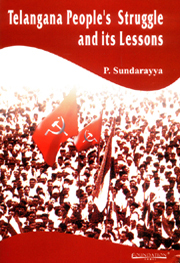Book contents
- Frontmatter
- Contents
- Preface
- Introduction
- PART I
- 1 Hyderabad State—its Socio-Political Background
- 2 The Peasant Upsurge and Communist Party
- 3 Armed Resistance Movement Against Nizam and Razakars
- 4 Telangana People's Armed Liberation Struggle Against Nizam – its Achievements
- 5 The Communist Movement in Andlira: Terror Regime—1948–1951
- PART II
- PART III
1 - Hyderabad State—its Socio-Political Background
from PART I
Published online by Cambridge University Press: 05 November 2011
- Frontmatter
- Contents
- Preface
- Introduction
- PART I
- 1 Hyderabad State—its Socio-Political Background
- 2 The Peasant Upsurge and Communist Party
- 3 Armed Resistance Movement Against Nizam and Razakars
- 4 Telangana People's Armed Liberation Struggle Against Nizam – its Achievements
- 5 The Communist Movement in Andlira: Terror Regime—1948–1951
- PART II
- PART III
Summary
The Hyderabad state which was formed by the Nizam, after the death of the last Mughal Emperor, was reduced to a subsidiary feudatory state, covering an area of about 83,000 square miles, under the British, after the cession of Berar of Maharashtra area and the coastal and the ceded districts of Andhra area to the British.
Multilingual State
The Hyderabad state consisted of three linguistic areas: the eight Telugu-speaking districts with Hyderabad city, the capital of the State, constituting the Telangana area; five Marathi-speaking districts, in the north-west of the State, constituting the Marathwada region; and three Kannada-speaking districts in the south-western part.
The Telangana region occupied 50 per cent of the area, as against 28 per cent of the Marathwada region, and the remaining 22 per cent of the Kannada region. The Telugu-speaking population in 1951 was 9,000,000 (50 per cent), Marathi-speaking about 4,500,000 (25 per cent) and Kannada-speaking 2,000,000 (11 per cent) while the Urdu-speaking population was 2,100,000 (12 per cent).
In no part of the State, except perhaps in Hyderabad city proper, were the Urdu-speaking people in majority. But since the Nizam was a Muslim, and it was his kingdom, Urdu was made the language of the courts and the administration at all levels, and also the medium of instruction from the primary stage. Only with the special permission of the Nizam and his administrators could private schools for children be started, even at middle school level, in the mother-tongues of the people—Telugu, Kannada and Marathi. Even language libraries and literary associations could be started only with the permission of the authorities. No wonder, the literacy rate was only 6 per cent.
- Type
- Chapter
- Information
- Telengana People's Struggle and it's Lessons , pp. 3 - 18Publisher: Foundation BooksPrint publication year: 2006



